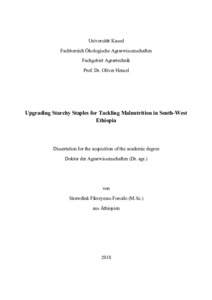| dc.date.accessioned | 2019-01-09T12:25:15Z | |
| dc.date.available | 2019-01-09T12:25:15Z | |
| dc.date.issued | 2018 | |
| dc.identifier | doi:10.17170/kobra-2019010888 | |
| dc.identifier.uri | http://hdl.handle.net/123456789/11023 | |
| dc.description.sponsorship | Bundesministerium für Bildung und Forschung | |
| dc.language.iso | eng | |
| dc.rights | Namensnennung-Nicht-kommerziell 3.0 Deutschland | * |
| dc.rights.uri | http://creativecommons.org/licenses/by-nc/3.0/de/ | * |
| dc.subject | Child undernutrition | eng |
| dc.subject | Food processing | eng |
| dc.subject | Starchy staples | eng |
| dc.subject | Ethiopia | eng |
| dc.subject | Complementary food | eng |
| dc.subject.ddc | 630 | |
| dc.title | Upgrading Starchy Staples for Tackling Malnutrition in South-West Ethiopia | eng |
| dc.type | Dissertation | |
| dcterms.abstract | Child undernutrition is a critical public health challenge in Ethiopia. One of the immediate causes of child undernutrition is inadequate dietary intake as a result of relying on one or few starchy staples. Utmost attention should be given to improving diets of infants and young children if significant and fast changes are to be seen in the reduction of undernutrition. This dissertation examines the potentials of utilising appropriate food processing technologies for developing upgraded food products for infants and young children.
Chapters 3 and 4 give an overview of nutritional status of children and their mothers. The prevalence of stunting, wasting and underweight is 25%, 13% and 9%, respectively. These rates are better than the national average, but still indicate a high severity of child undernutrition. Child undernutrition is mainly manifested as stunting which in turn is predicted by age, sex and place of residence. On the other hand, 16% prevalence of maternal chronic energy deficiency (CED) was recorded in the study area which was relatively lower than other regions in Ethiopia. The major predictors of CED were wealth, age and husband's occupation.
Chapter 5 examines the child feeding practices as well as nutrient adequacy of currently consumed complementary foods. Majority of the breastfeeding and complementary feeding practices meet the WHO recommendations except more than half of the children did not get minimum dietary diversity. The complementary foods fed to the children were cereal dominated and with few fruits and dairy products. The nutrient adequacy calculations showed that important nutrients like protein, Zn and Ca were not adequate in the sampled complementary foods while nutrients like fibre and ash were adequate. Among the complementary foods prepared by the mothers, cereal: pulse: oilseed blend was relatively better in the overall nutrient adequacy.
In chapters 6, 7 and 8, experiments on the development of upgraded complementary food products are presented. High- and low-tech food processing techniques were tested, and the quality, stability and acceptability of the developed food products were determined. Experiment on composite extruded complementary food showed it was feasible to produce nutritious, palatable and shelf-stable complementary food by optimally blending and extruding plant-based starchy ingredients. The upgraded baby food product can be used as a starting point for commercialisation by small and medium food enterprises. On the other hand, the experiment on household food processing techniques indicated that addition of 2.5% malt and fermentation for 24 hours improved the chemical, physical and sensory qualities of the complementary foods. Such food processing techniques should be promoted in countries like Ethiopia where they are not commonly practised for baby food applications. | eng |
| dcterms.accessRights | open access | |
| dcterms.creator | Forsido, Sirawdink Fikreyesus | |
| dcterms.dateAccepted | 2018-12-20 | |
| dcterms.extent | xvii, 156 Seiten | |
| dc.contributor.corporatename | Kassel, Universität Kassel, Fachbereich Ökologische Agrarwissenschaften | |
| dc.contributor.referee | Hensel, Oliver (Prof. Dr.) | |
| dc.contributor.referee | Gebresenbet, Girma (Prof. Dr.) | |
| dc.relation.projectid | 031A247A | |
| dc.subject.swd | Äthiopien | ger |
| dc.subject.swd | Kind | ger |
| dc.subject.swd | Unterernährung | ger |
| dc.subject.swd | Lebensmittelproduktion | ger |
| dc.type.version | publishedVersion | |


